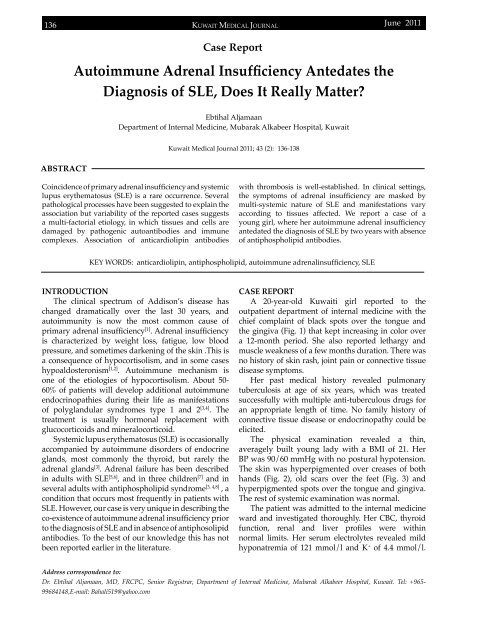Vol 43 # 2 June 2011 - Kma.org.kw
Vol 43 # 2 June 2011 - Kma.org.kw
Vol 43 # 2 June 2011 - Kma.org.kw
You also want an ePaper? Increase the reach of your titles
YUMPU automatically turns print PDFs into web optimized ePapers that Google loves.
136<br />
KUWAIT MEDICAL JOURNAL<br />
<strong>June</strong> <strong>2011</strong><br />
Case Report<br />
Autoimmune Adrenal Insufficiency Antedates the<br />
Diagnosis of SLE, Does It Really Matter<br />
Ebtihal Aljamaan<br />
Department of Internal Medicine, Mubarak Alkabeer Hospital, Kuwait<br />
Kuwait Medical Journal <strong>2011</strong>; <strong>43</strong> (2): 136-138<br />
ABSTRACT<br />
Coincidence of primary adrenal insufficiency and systemic<br />
lupus erythematosus (SLE) is a rare occurrence. Several<br />
pathological processes have been suggested to explain the<br />
association but variability of the reported cases suggests<br />
a multi-factorial etiology, in which tissues and cells are<br />
damaged by pathogenic autoantibodies and immune<br />
complexes. Association of anticardiolipin antibodies<br />
with thrombosis is well-established. In clinical settings,<br />
the symptoms of adrenal insufficiency are masked by<br />
multi-systemic nature of SLE and manifestations vary<br />
according to tissues affected. We report a case of a<br />
young girl, where her autoimmune adrenal insufficiency<br />
antedated the diagnosis of SLE by two years with absence<br />
of antiphospholipid antibodies.<br />
KEY WORDS: anticardiolipin, antiphospholipid, autoimmune adrenalinsufficiency, SLE<br />
INTRODUCTION<br />
The clinical spectrum of Addison’s disease has<br />
changed dramatically over the last 30 years, and<br />
autoimmunity is now the most common cause of<br />
primary adrenal insufficiency [1] . Adrenal insufficiency<br />
is characterized by weight loss, fatigue, low blood<br />
pressure, and sometimes darkening of the skin .This is<br />
a consequence of hypocortisolism, and in some cases<br />
hypoaldosteronism [1,2] . Autoimmune mechanism is<br />
one of the etiologies of hypocortisolism. About 50-<br />
60% of patients will develop additional autoimmune<br />
endocrinopathies during their life as manifestations<br />
of polyglandular syndromes type 1 and 2 [3,4] . The<br />
treatment is usually hormonal replacement with<br />
glucocorticoids and mineralocorticoid.<br />
Systemic lupus erythematosus (SLE) is occasionally<br />
accompanied by autoimmune disorders of endocrine<br />
glands, most commonly the thyroid, but rarely the<br />
adrenal glands [3] . Adrenal failure has been described<br />
in adults with SLE [5,6] , and in three children [7] and in<br />
several adults with antiphospholipid syndrome [3, 4,8] , a<br />
condition that occurs most frequently in patients with<br />
SLE. However, our case is very unique in describing the<br />
co-existence of autoimmune adrenal insufficiency prior<br />
to the diagnosis of SLE and in absence of antiphosolipid<br />
antibodies. To the best of our knowledge this has not<br />
been reported earlier in the literature.<br />
CASE REPORT<br />
A 20-year-old Kuwaiti girl reported to the<br />
outpatient department of internal medicine with the<br />
chief complaint of black spots over the tongue and<br />
the gingiva (Fig. 1) that kept increasing in color over<br />
a 12-month period. She also reported lethargy and<br />
muscle weakness of a few months duration. There was<br />
no history of skin rash, joint pain or connective tissue<br />
disease symptoms.<br />
Her past medical history revealed pulmonary<br />
tuberculosis at age of six years, which was treated<br />
successfully with multiple anti-tuberculous drugs for<br />
an appropriate length of time. No family history of<br />
connective tissue disease or endocrinopathy could be<br />
elicited.<br />
The physical examination revealed a thin,<br />
averagely built young lady with a BMI of 21. Her<br />
BP was 90/60 mmHg with no postural hypotension.<br />
The skin was hyperpigmented over creases of both<br />
hands (Fig. 2), old scars over the feet (Fig. 3) and<br />
hyperpigmented spots over the tongue and gingiva.<br />
The rest of systemic examination was normal.<br />
The patient was admitted to the internal medicine<br />
ward and investigated thoroughly. Her CBC, thyroid<br />
function, renal and liver profiles were within<br />
normal limits. Her serum electrolytes revealed mild<br />
hyponatremia of 121 mmol/l and K + of 4.4 mmol/l.<br />
Address correspondence to:<br />
Dr. Ebtihal Aljamaan, MD, FRCPC, Senior Registrar, Department of Internal Medicine, Mubarak Alkabeer Hospital, Kuwait. Tel: +965-<br />
99684148,E-mail: Bahali519@yahoo.com
















